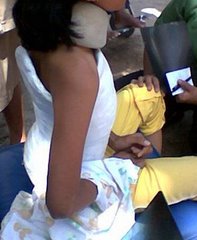Just as running water does not freeze, so moving muscles do not freeze.
Know the facts. The maintenance of normal muscle tone and function is an important aspect of the treatment of parkinsonism. In part, medication administered for your illness achieves this goal. However, to realize the full benefit of the medication daily exercise and activity are essential. This booklet outlines some of the exercises capable of maintaining muscle power and tone and preventing deformities of the limbs and spine. Their daily performance has proved most beneficial to patients with this illness.
TEN BASIC EXERCISES FOR THE PARKINSON PATIENT
1. Bring the toes up with every step you take. In Parkinson's disease, "you never make a move", without lifting the toes.
2. Spread the legs (10 inches) when walking or turning, to provide a wide base, a better stance, and to prevent falling. It may not look "beautiful," but neither does falling.
3. For greater safety in turning, use small steps, with feet widely separated. Never cross one leg over the other when turning. Practice walking a few yards and turn. Walk in the opposite direction and turn. Do so fifteen minutes a day.
4. Practice walking into tight corners of a room, to overcome fear of close places.
5. To insure good body balance, practice rapid excursions of the body. Backward, forward and to the right and left, five minutes, several times a day. Don't look for a wall when you think you are falling. It may not be there. Your body will always be there to protect you, if you will practice balance daily.
6. When the legs feel frozen or "glued" to the floor, a lift of the toes eliminates muscle spasm and the fear of falling. You are free to walk again.
7. Swing the arms freely when walking. It helps to take body weight off the legs, lessens fatigue, and loosens the arms and shoulders.
8. If getting out of a chair is difficult, rise with "lightning speed," to overcome the "pull of gravity." Sitting down should be done slow, with body bent sharply forward, until one touches the seat. Practice this at least a dozen times a day.
9. If the body lists to one side, carry a shopping bag loaded with books or other weights in the opposite hand to decrease the bend.
10. Any task that is difficult, such as buttoning a shirt. or getting out of bed, if practiced 20 times it day, becomes easier the 21st time.
FOR TIGHT MUSCLES AND POOR POSTURE
STANDING
1. Stand ln front of a wall, facing it about 8" away. Raise arms and reach as high as possible toward the top of the wall. Lean toward the wall and stretch.
2. With your back to the wall, alternate raising legs as high as possible by bending the knee as if marching in place.
3. Holding on to something secure, squat down as far as possible, bending knees; then come up.
SITTING
1. Sitting in straight-back chair, place your arms behind the chair and bring your shoulders back as far as possible; raise your head up and look at the ceiling.
2. Sitting In the same chair, grip the ends of a broom or mop stick with both hands, try to raise it over your head until you get it behind your head. Keep head and shoulders as erect as possible.
3. Sitting in same chair, place one leg at a time on another chair and press the knee straight. Keep it there 15 minutes. Try both legs together.
4. Sitting in a chair, raise legs up from the knee alternately, as if stamping your feet.
LYING ON A FIRM BED OR FLOOR
1. Lie on the floor or bed, flat on your back; try to press your body to the floor as flat as possible. Move your head from right to left as far as possible. Make sure your head, shoulders, back, and knees touch the surface.
2. Lie on the floor or bed on your abdomen. Do the following one by one:
- Put your hands behind back and look up to ceiling, trying to raise your chest off the floor.
- Kick your legs alternately, as if swimming.
- Turn your head from right to left.
FOR BETTER BALANCE
1. Stand with hands on hips, feet spread apart:
- Practice marching in place
- Practice raising leg straight out to the rear.
- Practice raising leg out to the side.
- Practice drawing a circle with the leg.
2. Standing with hands at side, feet spread apart:
- Lean forward and back
- Lean to both sides
- Lean in a circular motion and reverse the motion
FOR WALKING
1. When walking, REMEMBER:
- Take as large a step as possible
- Raise your toes as you step forward, hitting ground with your heels
- Keep legs apart and posture straight
- Swing arms and look straight ahead - your feet know where the floor is located.
2. Collect a dozen magazines; lay them out in a straight line. Space them so that you can take as long a step as possible. Practice walking over these magazines without stepping on them.
3. For a better swing to arms, walk holding a rolled magazine in each hand; keep elbows straight.
4. Practice walking sideways, backwards, and take big steps.
FOR TURNING
1. When practicing turning:
- Keep feet spread-apart and head high
- Use small steps; rock front side to side
- Raise legs from the knees
2. If you feel glued to the floor:
- Raise your head, relax back on your heels and raise your toes
- Rock from side to side, bend knees slightly and straighten up and lift your toes
- It sometimes helps if the arms are raised in a sudden short motion
FOR GETTING IN AND OUT OF A CHAIR
1. If you become glued a few steps before you reach the chair, try this: Don't aim for the chair but some object past it. Pass the chair as closely as possible and as you go by it sit down.
2. To sit down, bend forward as far as possible and sit down slowly. Get close to the chair. Do not fall into the chair.
3. To get up, move to the edge of the chair, bend forward and push up vigorously using your arms; try to count 1 2 3 GO! If you have a favorite armchair, raise the back legs with 4" blocks. This will help you to get up easily. Don't let people drag you up by your arms, but help you by pulling you under your arms, or with a slight push on your back.
FOR GETTING OUT OF BED
1. Place blocks under the legs of the head of the bed. This will elevate the head of the bed, & make it easier for you to sit up and swing the legs off the bed.
2. A knotted rope tied to the foot of the bed can help you to pull yourself up.
3. To get to a sitting position, shift the body down and rock yourself by vigorously, throwing your arms and legs toward the side of the bed.
FOR USING YOUR ARMS AND HANDS
1. Practice buttoning and unbuttoning your clothes; practice cutting food and writing. Squeeze a ball or work with "Silly Putty." Keep your fingers busy many times a day. Tear paper; take coins out of the pocket; play the piano.
2. Always try to dress yourself completely. Use shoehorns, elastic laces, or extra-long shoelaces to get a better grip. Dress in the most relaxed and comfortable position, sitting or standing, but make sure you are in a safe position.
3. To keep elbows straight and shoulders loose, install a pulley in doorway, place a chair under it or slightly in front. Stretch your arms and shoulders in all directions. By working the pulley when seated, you can get a more vigorous pull.
FOR GREATER SAFETY IN BATHTUB AND TOILET
If it is difficult to sit down in a bathtub, try the following:
1. Place a bench, stool or chair inside the tub; have the legs sawed off to tub height. Sit on the chair and soap yourself. Use shower to rinse, or rubber shower extension.
2. Bathtub grab bars are available. Purchase only those that attach securely.
3. Raised toilet seats are commercially available.
4. Toilet armrest for getting on and off the toilet are available.
FOR SPEECH, FACE AND CHEWING DIFFICULTIES
1. Practice singing and reading aloud with forceful lip movements. Talk into a tape recorder, if one is available.
2. Practice making faces in front of a mirror. Recite the alphabet and count numbers with exaggerated facial motions. Massage your face with vigor when washing and bathing.
3. When chewing food, chew hard and move the food around; avoid swallowing large lumps.
The previously outlined general exercises and suggestions are designed to help you. They are ancillary to medical treatment which should be carried out in consultation with your physician. In special instances where other diseases are associated with parkinsonism, your physician may wish to limit the intensity of your physical activity. Conversely, more intensive physical therapy may be indicated and in some instances should be done under the direction of a physical therapist.
All activities possible should be engaged in: work, walking, shopping, house chores, gardening, visiting, senior clubs, church organizations, travel, theater, swimming, sports, gymnasium, health clubs, "Y" activities, etc.
Home | News/Events | Clinical Trials | Papers/Essays | About CNS | Helping CNS | Links
The Center for Neurologic Study
© 2002 All rights reserved.
Comments about the site? Let us know.







